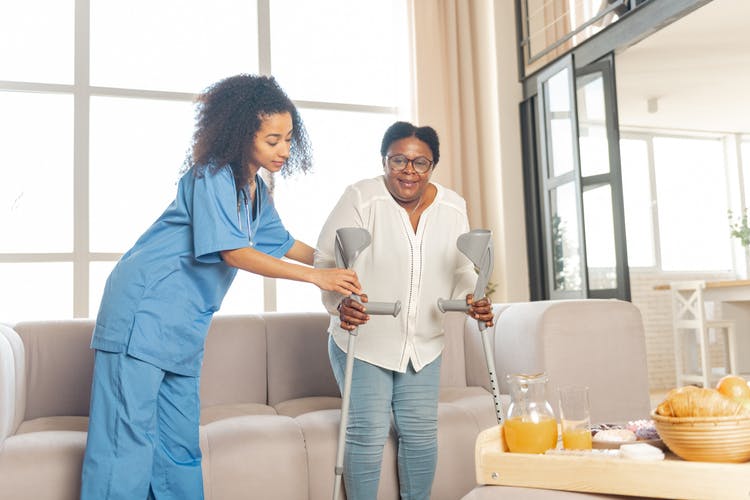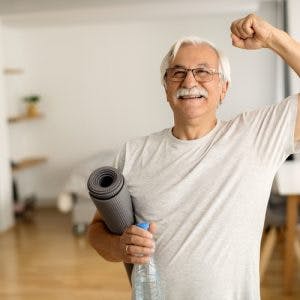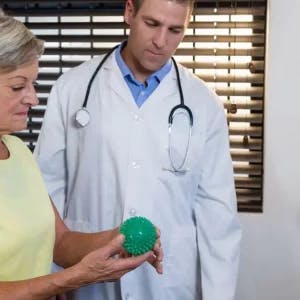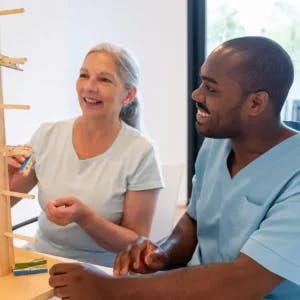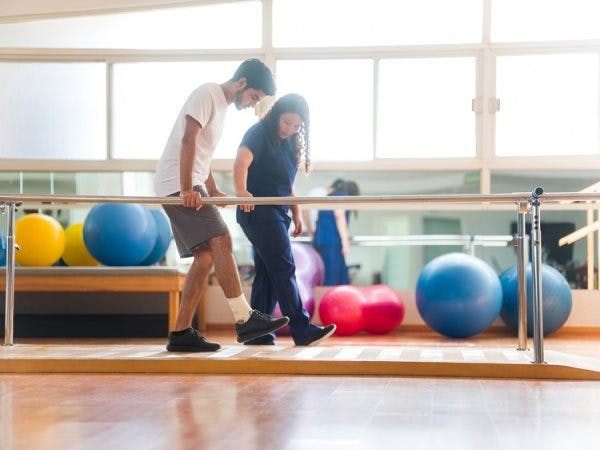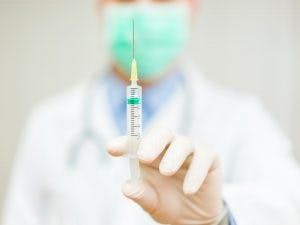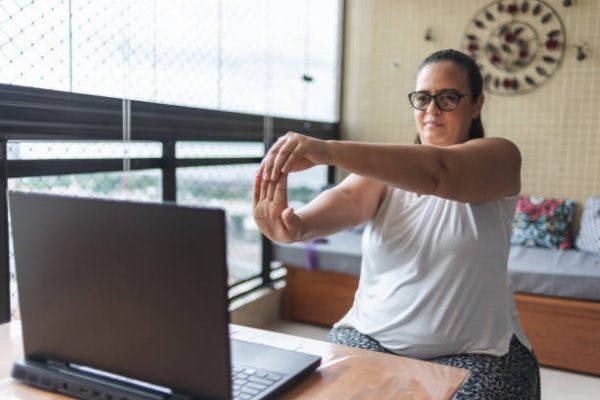Taking precautions to prevent falling after stroke can help survivors avoid further complications and may even save a life. Falls are the second leading cause of accidental home deaths (behind poisoning). Additionally, falls are the primary reason for 25% of hospital admissions and 40% of admissions to nursing homes.
Among stroke survivors, approximately 7% of individuals fall within one week of their stroke, and 73% experience a fall within one year of their stroke. Ignoring the significance of these statistics can be detrimental to stroke survivors. Therefore, it is essential for survivors, family members, and healthcare professionals alike to take appropriate steps to prevent falling after stroke.
This article will outline how a stroke may increase the likelihood of falls and detail specific ways to prevent falling after stroke. Please use the links below to jump directly to any section of this article.
- Why are falls more likely after stroke?
- Safety measures to prevent falling after stroke
- Rehabilitation for fall prevention
The Impact of Stroke on a Survivor’s Fall Risk
Learning how a stroke may increase the risk of falling can help survivors and their loved ones further understand how to prevent falling after stroke. The following list describes some of the secondary effects of stroke that may increase the risk of falling:
- Motor deficits. Muscle weakness and poor coordination, along with an inability to catch one’s balance due to decreased upper extremity functions, may increase a survivor’s fall risk.
- Sensory changes. Since the senses play a vital role in preventing falls, the possibility of falling may be more likely following changes to certain sensory systems, such as the vestibular system (responsible for balance), tactile system, and visual system.
- Perceptual changes. Changes in how the body interprets sensory input, such as occurs in hemineglect (the inability to pay attention to one side of the body) or anosognosia (a lack of insight into one’s deficits), may result in falling.
- Cognitive effects. Changes such as impaired judgement, trouble with multitasking, difficulties with sequencing and problem-solving challenges may contribute to an increased fall risk.
- Psychological changes. Depression, among other psychological changes, may occur following stroke and can increase the likelihood of falling.
In addition to these secondary effects of stroke contributing to the risk of falls, some survivors are at risk due to other conditions, such as post-stroke epilepsy. Adverse effects of medications and cardiovascular risk factors, including hypotensive conditions like syncope, may also increase a survivor’s risk of falls.
However, by pursuing rehabilitation and taking preventative measures, individuals can drastically reduce their risk of complications and boost their recovery outcomes. Therefore, it is important for survivors and their loved ones to ensure they are taking the necessary steps to prevent falling after stroke.
Safety Measures to Prevent Falling After Stroke
There are a number of safety measures that survivors and their families can use to help prevent falling after stroke. Ensuring that safety measures are in place before the survivor returns home from the hospital (or enters any new environment) is an excellent way to reduce falls.
Since many falls occur due to environmental hazards (cords on the floor, steps without a handrail, etc.), survivors and their loved ones should strive to set up the survivor’s surroundings as safely as possible. Occupational therapists can be a great resource in this area.
While many occupational therapists are able provide survivors with a list of generalized home safety recommendations to consider upon hospital discharge, some can also perform home visits. In addition to providing the opportunity for survivors to practice moving safely throughout their home, a home visit can also allow survivors and their loved ones to receive personalized fall prevention recommendations.
Common recommendations for home modifications to prevent falling after stroke include:
- Adding non-slip mats and grab rails to the bath
- Ensuring adequate lighting throughout the home, including using nightlights to prevent falls after dark
- Adding a transfer bench to the bath and/or a shower chair to the shower
- Clearing walkways of obstacles and removing clutter
- Raising the height of toilet seats
- Ensuring cords stay out of all walkways
- Removing throw rugs or other floor mats that are a tripping hazard
Taking measures to set up a survivor’s home safely has been shown to be an effective way to proactively prevent falls. However, it is also essential for survivors to take steps to minimize their personal fall risk factors to prevent falling after stroke.
Rehabilitation for Fall Prevention
In addition to boosting recovery, managing the secondary effects of stroke through rehabilitation can help survivors prevent falls. As seen above, many of the secondary effects of stroke make falls more likely. Therefore, addressing these deficits through rehabilitation can reduce the chances of falling.
Here are some excellent steps to help prevent falling after stroke:
1. Improve Motor Skills
Pursuing physical and/or occupational therapy can help survivors regain balance, strength, and mobility after stroke. While physical therapists focus on improving movement through hands-on techniques and targeted exercises, occupational therapists focus on improving functional skills to optimize participation in the activities of daily living.
Although they have different focuses, both physical and occupational therapies encourage consistent, repetitive practice of affected functions to optimize recovery through neuroplasticity, or adaptive brain rewiring. This is why it is essential to not only practice leg, core, and balance exercises during therapy, but also to continue practicing these skills through a home program.
While many therapists provide home programs to encourage recovery, some survivors choose to use gamified home therapy programs, such as FitMi. Using a gamified program can often boost a survivor’s motivation to continue exercising at home. In turn, this can improve survivors’ persistence with therapy, promote recovery of affected functions, and reduce their personal fall risk factors.
2. Address Vision Concerns
Vision plays a significant role in one’s sense of balance. Thus, when vision is affected by a stroke, individuals have a higher likelihood of falling. There are a number of vision changes that may occur after stroke, including:
- Visual field cuts: part of the visual field is lost
- Eye movement disorders: result from difficulties controlling the eye muscles
- Visual neglect: inattention to one side of the visual field
When vision is affected, survivors are unable to clearly navigate their environment, making it more difficult to avoid falls. Optometrists, neurologists, and occupational therapists, especially those specially trained in vision rehabilitation, are all great resources to help with treating and managing vision concerns.
3. Manage Secondary Conditions
Many stroke survivors develop secondary conditions that increase their fall risk. While every stroke is unique, many survivors will experience one or more conditions that increase their likelihood of falling, including:
- Hemiplegia or hemiparesis: paralysis or weakness on one side of the body, resulting in impaired balance, especially if the legs or trunk are affected. These conditions are often addressed in physical and occupational therapy.
- Foot drop: difficulty lifting the front part of the foot. This is managed by using an ankle foot orthotic, such as the Flex AFO, or through targeted physical therapy exercises.
- Hemineglect: a lack of attention to one side of the body/environment. Treatments often include compensatory techniques, such as visual scanning and/or prism adaptation.
- Executive dysfunction: difficulties with higher-level cognitive functions, which can be associated with a higher fall risk. Executive dysfunction may be addressed through cognitive rehabilitation with a speech and/or occupational therapist.
- Vertigo: a sense of spinning or dizziness. Depending on the cause, vertigo may be able to be addressed by a physical therapist who specializes in vestibular rehabilitation.
- Depression: persistent sadness and a lack of interest in previously enjoyed activities, often treated through medications and/or psychotherapy. Both depression itself and the use of antidepressants can be associated with an increased fall risk.
Since these conditions can each be related to a higher likelihood of falling, it is essential for survivors to address them in a timely manner. Consulting with one’s primary care team and/or therapists is a great way to learn which secondary conditions survivors should work to address to prevent falling after stroke.
In addition to the above considerations for rehabilitation to prevent falls, survivors should practice being mindful of their bodies and environment when moving. Moving carefully and at a steady pace while using appropriate medical equipment (such as a cane, walker, or hemi walker) is essential for reducing the risk of falls. Asking for help to complete physical tasks, when necessary, can also be a great way to avoid falling.
While the recovery process can be frustrating at times, even small steps in the right direction can gradually lead to significant improvements. By setting up the environment for success and pursuing rehabilitation, survivors can prevent falling after stroke and optimize their recovery.
Understanding How to Prevent Falls After a Stroke
Falls are commonly experienced by stroke survivors. Many secondary effects of stroke can increase one’s fall risk, making it essential for stroke survivors, caregivers, and family members to ensure proper fall prevention measures are in place.
Through modifying the home environment and pursuing rehabilitation, survivors can reduce their likelihood of experiencing a fall. Using personal and environmental fall prevention strategies can not only reduce the chances of developing further complications after stroke, but may even save a life.

